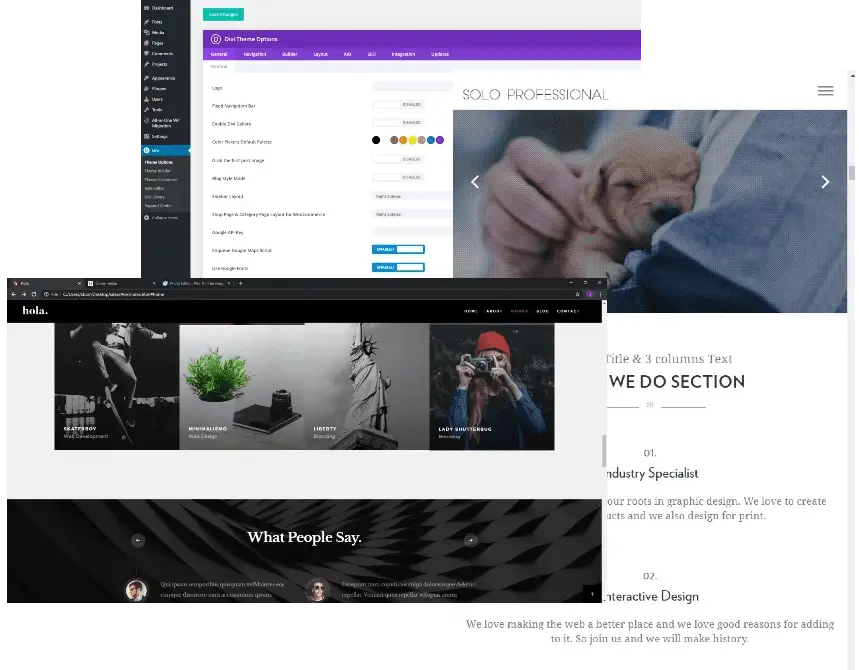How to Optimize Your eCommerce Website For Mobile Devices

Mobile devices are a crucial part of modern-day society, and eCommerce businesses are no exception. In fact, studies show that over 50% of online sales in the UK are made through mobile devices.
Therefore, it’s essential to optimise your eCommerce website for mobile devices to meet the demands of your customers and stay ahead of the competition.
In this article, we’ll explore various strategies for optimising mobile experiences on eCommerce websites for all devices in the UK. We’ll look at what mobile web design is, user experience, mobile-first design, mobile SEO, and page speed optimisation.
What is mobile web design?

Mobile web design is the process of designing a website to ensure that it’s mobile-friendly, responsive, and user-friendly. The primary goal of mobile friendly design is to create responsive website design for a seamless experience for visitors, regardless of the device they use to access your site.
It’s a design strategy that enables your site to adjust its layout, images, text messages and font size to suit the size of the user’s screen.
User Experience
The user experience (UX) is a vital part of any eCommerce website, and it’s even more critical for mobile devices. You need to ensure that your website is easy to navigate, loads quickly, and provides a seamless experience for users.
A user-friendly website is more likely to encourage users to stay longer, browse your products, and make a purchase.
First Generation: Subdirectories and subdomains, with or without forced redirects
The first-generation approach to mobile web design involved creating separate mobile subdomains or subdirectories. This strategy allows businesses to create a mobile version of their website that’s separate from their desktop version.
However, this approach has several limitations, such as reduced website speed, duplicate content, and difficulty in managing multiple versions of the site’s performance and the mobile site together.
Minimize your use of text on product pages

When it comes to optimizing ecommerce websites for mobile devices in the uk too, less is more. It’s essential to minimise the amount of text on your product pages to avoid clutter and make it easier for users to find the information they need quickly. Focus on providing the essential information users interact with, such as product description, price, and reviews.
Advantages and limitations of mobile responsive sites
The second generation of mobile web design involved creating mobile-responsive websites that adjust to the small screen size of the user’s mobile device. This approach provides a better user experience, reduces the need for multiple versions of the site, and improves website speed.
However, there are limitations to this approach, such as images that aren’t optimised for mobile devices, which can affect the loading time of the site.
Considerations for eCommerce websites
When optimising an eCommerce website for mobile devices, there are several factors to consider. These include website speed, user experience, navigation, product pages, checkout process, and mobile SEO.
It’s essential to create a website that meets the needs of your potential customers well, encourages them to stay longer, and makes it easy for them to make a purchase.
Smooth your website navigation and offer a guest checkout option
Smooth website navigation is crucial for any eCommerce website, and it’s even more important for mobile devices. Ensure that your website is easy to navigate and offers a seamless experience for users.
Additionally, offering a guest checkout option for mobile searches can reduce cart abandonment rates for mobile transactions and increase the likelihood of users making a purchase.
Google’s Mobile-First Index

Google’s mobile-first index means that Google now uses the mobile version of a website to rank its pages, rather than the desktop version. This means that it’s essential to ensure that the mobile traffic to your eCommerce website is optimised for smaller devices and meets Google’s mobile-first indexing requirements.
Important Factors of a Mobile SEO Strategy in 2023
A mobile SEO strategy involves optimising your eCommerce website for mobile devices to improve its ranking on search engines. It includes factors such as website speed, mobile responsiveness, structured data markup, and mobile-first indexing. By optimising your e commerce website for mobile SEO, you’ll improve its visibility on search engines and increase the likelihood of attracting new customers.
Start thinking of ecommerce design as mobile-first
A mobile-first design approach involves designing your website with mobile devices in mind before creating a desktop version. This strategy helps to ensure that your website provides a seamless experience for users, regardless of the device they use to access it. Additionally, a mobile-first design approach can improve website speed, reduce bounce rates, and increase conversions.
Third Generation: Responsive web design with Adaptive Logic

The third generation of mobile web design involves responsive web design with adaptive logic. This approach uses server-side programming to detect the device type and screen size of the user and adjust the website’s layout accordingly. It offers the advantages of mobile-responsive sites, with the added benefits of faster loading times and reduced data usage.
Create responsive, eye-catching website design
An eCommerce website’s design is crucial for creating a positive user experience, increasing engagement, and encouraging users to make a purchase. When designing your website for mobile ecommerce, ensure that it’s responsive, eye-catching, and provides a seamless experience for users.
Is your eCommerce website mobile-friendly?
It’s essential to ensure that your eCommerce website is mobile-friendly to meet the demands of modern-day consumers. You can check whether your website is mobile-friendly by using Google’s Mobile-Friendly Test tool. This tool analyses your website’s layout, font size, and other factors that affect its mobile-friendliness.
Optimize your e-commerce site for mobile and ensure blazing-fast loading speeds

Website speed is a crucial factor in providing a positive and seamless user experience for mobile users. Ensure that your website loads quickly by optimising images, reducing HTTP requests, and using caching. Additionally, ensure that mobile design of your website is responsive and mobile-friendly to provide a seamless experience for users.
Use structured data markup
Structured data markup helps search engines to understand the content of your website and display it more prominently in search engine results pages. By using structured data markup, you can top search results, improve your website’s visibility on search engines, increase traffic, and attract new customers.
Fifth Generation: Single Page Application (SPA) websites
The fifth generation of mobile web design involves Single Page Application (SPA) websites. SPA websites provide a seamless experience for users by loading all the website’s content on a single page, without the need for multiple page refreshes. This approach improves website speed, reduces data usage, and provides a more engaging experience for users.
Ensure user-friendly navigation
User-friendly navigation is crucial for any eCommerce website, and it’s even more important for mobile users. Ensure that your website’s navigation is easy to use, intuitive, and provides a seamless experience for mobile visitors, online shoppers and users.
Simplify your mobile form interactions
Simplifying mobile form interactions can improve the user experience, reduce cart abandonment rates, and increase conversions. Ensure that your website’s forms are simple, easy to use, and require minimal input from users.
Show only optimized images and videos

Showing only optimised images and videos on mobile websites can improve website speed, reduce data usage, and provide a better user experience for mobile users. Ensure that your website’s images and videos are optimised for mobile devices to provide a seamless experience for users.
Influence action with a sticky “Add to Cart” button
A sticky “Add to Cart” button can improve website speed, reduce cart abandonment rates, and increase conversions. Ensure that your website’s “Add to Cart” button is prominently displayed, easy to use, and provides a seamless experience for users.
Institute intuitive checkout processes
Intuitive checkout processes can reduce cart abandonment rates and increase conversions.
Provide Guest Checkout Option
A guest checkout option allows customers to make a purchase without creating an account on your website. This option can simplify the checkout process and reduce cart abandonment rates, especially for customers who are making a one-time purchase. By providing a guest checkout option, you can offer your customers more flexibility and increase the likelihood of completing a sale.
However, keep in mind that creating an account has its benefits. It can allow customers to save their information, track their orders, and receive special offers. Therefore, consider providing both options on your website to cater to different customer preferences.
Additionally, ensure that the process for creating an account is simple and doesn’t require too much time or effort from the customer.
By instituting an intuitive checkout process, you can make it easy for customers to complete a purchase on your mobile eCommerce site or website. Ensure that the checkout process is streamlined, user-friendly, and provides a seamless experience for users.
Remember that a positive checkout experience can lead to increased customer satisfaction, repeat purchases, and positive reviews.
Mobile page speed optimization
Mobile page speed is a crucial factor in eCommerce websites. According to Google, the average time for mobile ecommerce sites to load is around 15 seconds, while the recommended time is three seconds or less. Slow mobile page speeds can lead to higher bounce rates, lower conversions, and dissatisfied customers.
To optimize mobile page speed, consider implementing the following strategies:
Optimize images for mobile devices by reducing file size and using compression techniques.
Minimize HTTP requests by combining files, using browser caching, and minifying code.
Use a content delivery network (CDN) to distribute your website’s content across multiple servers.
Prioritize above-the-fold content by loading it first to improve perceived page speed.
Use a responsive design that can adapt to different screen sizes without sacrificing loading speed.
Increase commerce conversions on mobile devices

Finally, increasing conversions on mobile sites is a crucial aspect of mobile eCommerce sales and website optimization. To increase conversions, consider the following strategies:
Simplify the checkout process by removing unnecessary steps and requiring only essential information.
Offer multiple payment options, including mobile payment methods.
Display trust signals such as security badges, customer reviews, and return policies.
Optimize product pages for mobile conversions by using large, high-quality images, clear descriptions, and customer reviews.
Use retargeting ads to remind users of products they’ve viewed or added to their cart.
Benefits of Using Google Pay and Apple Pay for Ecommerce

We saved the best for last. There is no excuse not to have these impulse-buy buttons on your ecommerce site.
In recent years, the use of digital payment methods has become increasingly popular in ecommerce. Google Pay and Apple Pay are two of the most widely used digital payment options, and they offer a range of benefits for both merchants and customers.
Convenience: One of the main advantages of using Google Pay and Apple Pay for ecommerce is the convenience they provide. Customers can simply use their mobile devices to make a payment, without having to enter their card details or billing address every time they make a purchase.
Speed: Digital payments are much faster than traditional payment methods, such as credit cards or cash. With Google Pay and Apple Pay, customers can complete a transaction with just a few taps on their phone, making the checkout process much quicker.
Security: Both use advanced security features, such as tokenization and biometric authentication, to protect users’ payment information. This helps to reduce the risk of fraud and makes online transactions more secure.
Loyalty Programs: Google Pay and Apple Pay also offer the ability to store and use loyalty cards and reward programs. This makes it easier for customers to earn and redeem rewards, which can be a powerful motivator to continue shopping with a particular merchant.
Integration: Many ecommerce platforms now offer integration with Google Pay and Apple Pay, making it easy for merchants to accept these payment methods without having to set up their own payment gateway. This can save time and reduce costs for merchants, while also providing a better user experience for customers.
Overall, the use of these payment options for ecommerce offers a range of benefits that can help to improve the shopping experience for customers, increase sales for merchants, and reduce the risk of fraud and security breaches. As such, it’s a payment option that is well worth considering for any ecommerce business looking to stay ahead of the curve.
Conclusion
In conclusion, optimizing eCommerce websites for different devices is crucial for meeting the needs of modern-day consumers and staying ahead of the competition. By following the strategies outlined in this article, you can improve your website’s mobile-friendliness, user experience, SEO, page speed, and conversions. Keep in mind that mobile optimization is an ongoing process that requires continuous monitoring, testing, and refinement to ensure that your mobile website always provides the best possible experience for your customers.
